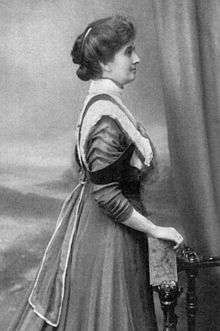Fanny Gates
| Fanny Gates | |
|---|---|
 | |
| Born |
26 April 1872[1][2] Waterloo, Iowa, United States[1] |
| Died |
24 February 1931 (aged 58)[1][2] Chicago, United States[1] |
| Nationality | American |
| Alma mater |
Northwestern University; University of Pennsylvania |
| Occupation | Professor of Physics |
Fanny Cook Gates (26 April 1872 – 24 February 1931) was an American physicist, an American Physical Society fellow and American Mathematical Society member.[3] She made contributions to the research of radioactive materials, determining that radioactivity could not be destroyed by heat or ionization due to chemical reactions, and that radioactive materials differ from phosphorescent materials both qualitatively and quantitatively.[4] More specifically, Gates showed that the emission of blue light from quinine was temperature dependent, providing evidence that the emitted light is produced from phosphorescence rather than radioactive decay.[5]
Education and career
Gates received her B.S. from Northwestern University in 1894 and her M.A. in 1895, and finally her Ph.D. from the University of Pennsylvania in 1909. She published two papers during graduate school on the subject of radioactivity.[1][5][6]
From 1895-1897, she was a scholar and fellow in mathematics at Bryn Mawr College, where she received a President's European Fellowship. In the fall of 1897 she attended the University of Göttingen to further her studies in mathematics and physics; and in the winter of 1898, furthered her studies at the Polytechnik Institute at Zurich. Gates returned to the U.S. in 1898 to accept a position at the Women's College of Baltimore (Goucher University), where she ordered in advance of her arrival, additional physics equipment to build her lab to study spectra and X-rays. She remained at Goucher for 13 years. From 1902-1903 she worked with Ernest Rutherford at McGill University, Montreal, where her research on radioactivity continued, proving that radioactive phenomena were not simple chemical or physical processes. In 1905, Gates worked with J.J. Thomson, her research continued to support her reputation in the scientific community.[7]
In 1911, she left her position at Goucher in Baltimore to accept a research position at the University of Chicago. Two years after that she was offered a Professor of Physics and Dean of Women position at Grinnell College in Iowa. She continued in this role for three years before moving to the University of Illinois, Urbana-Champaign in 1916, where she held the position of Associate Professor of Physics and Dean of Women, and served on the policy and planning committee of the university.[8][9]
Death
Fanny Gates continued to work until her passing in Chicago on February 24, 1931. While the cause of her death was either undetermined or unreported, like many early scientists working with radioactive materials, it has been written that her death may have been due to a radiation-related disease.[8]
References
- 1 2 3 4 5 A Devotion to Their Science: Pioneer Women of Radioactivity. Chemical Heritage Foundation. 1997. pp. 138–144. ISBN 978-0-941901-15-4.
- 1 2 Fanny Cook Gates (1872–1931) – Find A Grave Memorial. Findagrave.com. Retrieved on 2014-04-22.
- ↑ "Members of the Society". Bulletin of the American Mathematical Society. 13: 11. 1907. doi:10.1090/S0002-9904-1907-01395-2.
- ↑ Byers, Moszkowski, Wong. "Fanny Cook Gates, 1872–1931". Contributions of 20th Century Women to Physics. CWP at UCLA. Retrieved 2014-02-01.
- 1 2 Gates, Fanny Cook (1904). "On the Nature of Certain Radiation from the Sulphate of Quinine". Physical Review, Series 1. 18: 135. doi:10.1103/physrevseriesi.18.135.
- ↑ Gates, Fanny Cook (1903). "Effect of Heat on Excited Radioactivity". Physical Review, Series 1. 16 (5): 300. doi:10.1103/PhysRevSeriesI.16.300.
- ↑ Rayner-Canham, Marelene F.; Rayner-Canham, Geoffrey (1997). A Devotion to their Science: Pioneer Women of Radioactivity. Philadelphia: Chemical Heritage Foundation. ISBN 9780941901154.
- 1 2 CHF
- ↑ Rayner-Canham, Marelene F.; Rayner-Canham, Geoffrey W. (1997). "Fanny Cook Gates, Physicist (1872-1931)". Journal of Women and Minorities in Science. 3 (1-2.40): 53–63. doi:10.1615/JWomenMinorScienEng.v3.i1-2.40. Retrieved 29 November 2015.